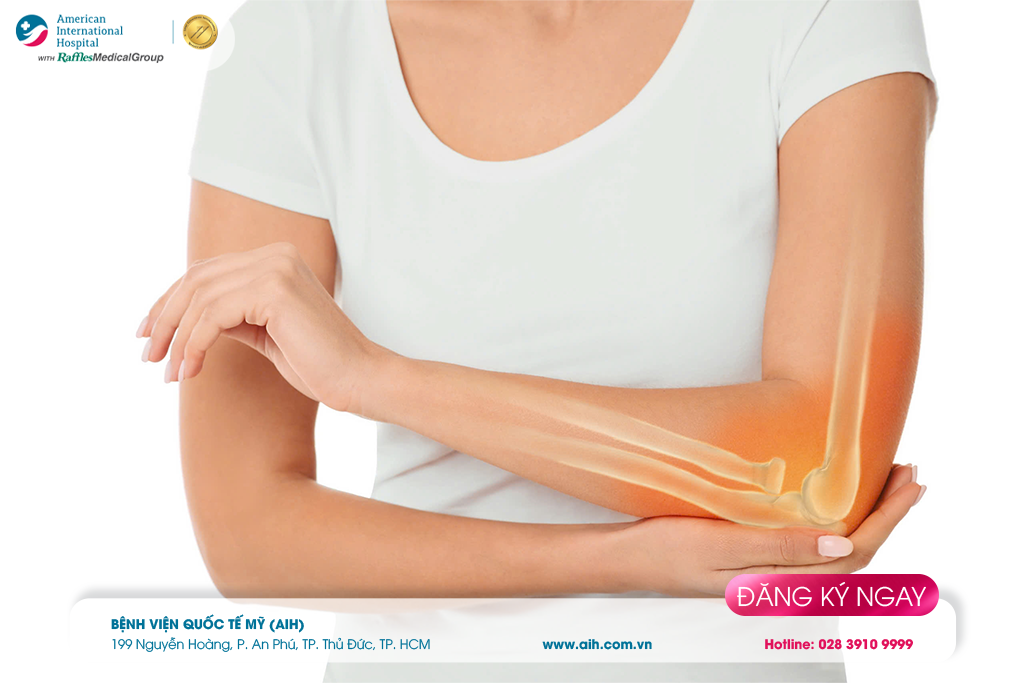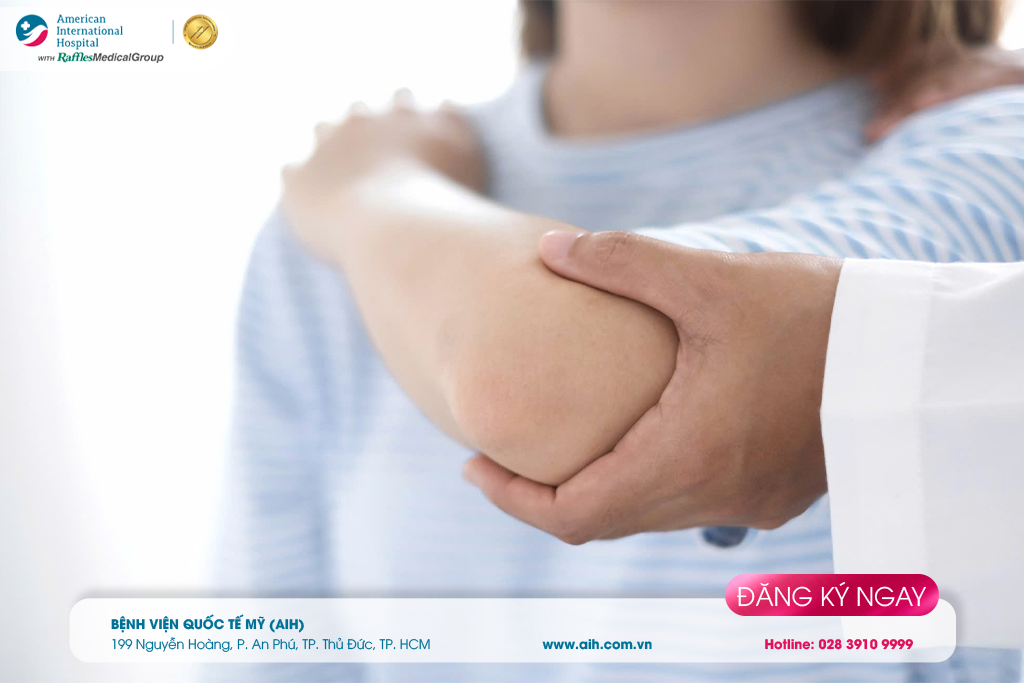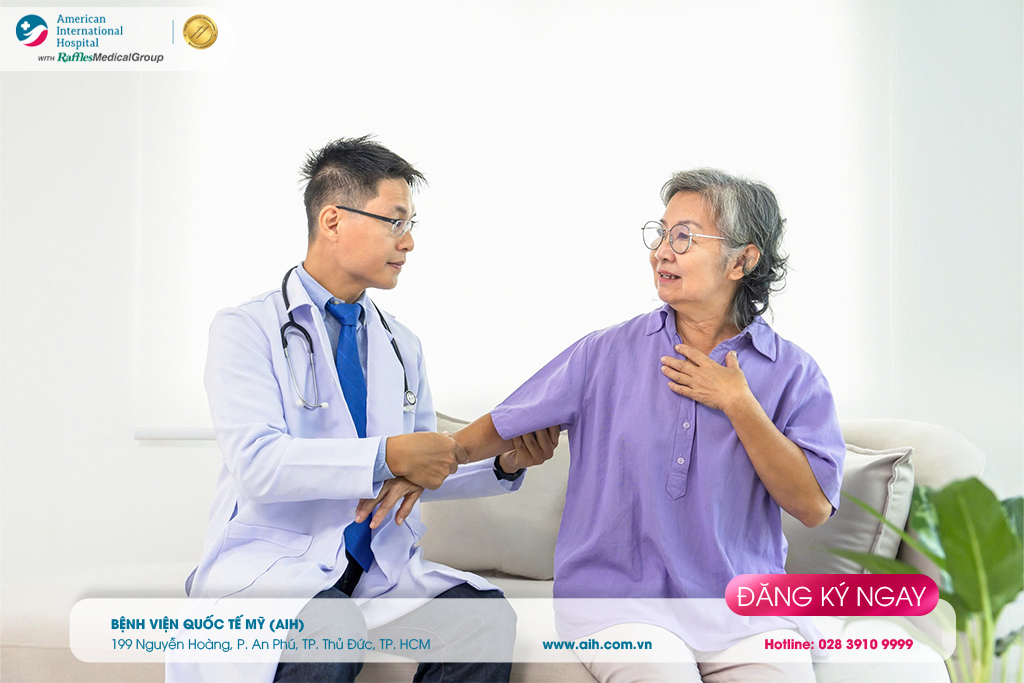Đặt lịch khám
Ngày
Chọn ngày thăm khám
Chuyên khoa
Chọn chuyên khoa bạn muốn thăm khám trong danh sách bên dưới
Bác sĩ
Hãy tham khảo thông tin từ danh sách bên dưới để chọn bác sĩ phù hợp
Giờ
Chọn thời gian thăm khám
Điện thoại
Vui lòng nhập số điện thoại di động để nhận sự hỗ trợ tốt nhất
Thông báo
Vui lòng điền vào thông tin bên dưới
*
*
*
*
*
*
Khẩn cấp
HOW TO TREAT ELBOW PAIN?
The elbow is prone to injuries due to the constant mechanical strain of daily activities. When injured, a painful elbow can limit arm movement, mobility, and impact a patient’s quality of work and life. Here, we’ll explore the causes, prevention, and treatment of elbow pain with AIH to ensure timely intervention.
► Elbow anatomy
Elbow is a joint formed where the humerus, radius and ulna meet. Each bone has a cartilage layer at its end, helping them glide and absorb shocks. The bones are kept in place by tough tissues called ligaments. Tendons connect bones to muscles, allowing us to move the arms in various ways and perform basic and complex movements such as throwing, lifting, swinging and hugging. However, this also makes the elbow more susceptible to injuries.
► Individuals at risk of having elbow pain
Elbow pain usually affects those who engage in repetitive elbow movements (gripping, lifting) excessively in work, sport or activities in that nature, for example:► Elbow anatomy
Elbow is a joint formed where the humerus, radius and ulna meet. Each bone has a cartilage layer at its end, helping them glide and absorb shocks. The bones are kept in place by tough tissues called ligaments. Tendons connect bones to muscles, allowing us to move the arms in various ways and perform basic and complex movements such as throwing, lifting, swinging and hugging. However, this also makes the elbow more susceptible to injuries.
► Individuals at risk of having elbow pain
- Products assemblers, assembly line workers in factories, or manufacturing plants.
- Individuals whose jobs require extensive arm use such as chefs, artists, carpenters, etc.
- Sport enthusiasts, athletes who play sports that require significant arm strength such as baseball, tennis, weightlifting, push-ups, etc

► Causes of elbow pain
- Pathological causes: Most elbow pain arises from strain or inflammation in soft tissues, such as: tendonitis, arthritis, bursitis, etc.
- External causes: Elbow pain can be a result of external factors including fall-related injuries, contact sport injuries, bone fractures, sprains, muscle strains, dislocation and tendon rupture.
- Wear and tear causes: Injuries caused by repetitive movements over time can lead to wear-and-tear injuries, often caused by sports like tennis or golf or specific job requirements
► Symptoms of elbow pain
- Pain in one or both arms
- Pain in the lateral or medial side of the elbow
- Feeling of pain deep in the elbow joint
- Throbbing pain
- Dull pain
- Numbing or tingling sensation in the arm or hand
- Joint stiffness
- Swelling
- Reduced gripping strength
- Inability to move the elbow or limited range of motion
- Bruising

► Diagnosing elbow pain
- Elbow X-Ray: check for bone injuries, fractures or arthritis
- Elbow ultrasound: quickly locate injured parts in the skeletal system
- MRI: examine the soft tissues surrounding joints, cartilages, ligaments, capillaries and nerves
- Electromyogram: use mild electric shocks to stimulate and measure nerve response speed
► Treatment for elbow pain
- Medication: Based on the pain level, doctors can indicate several types of over-the-counter painkillers, including:
- Acetaminophen
- Aspirin
- Non-steroid Anti-Inflammatory Drugs (NSAIDs) such as ibuprofen and naproxen
If ineffective, doctors can prescribe stronger painkillers or corticosteroid injections
- Physiotherapy: Physiotherapy is proved to be effective in improving muscle strength, reducing inflammation, restoring range of motions and elbow flexibility.
- Wrist stretching: Extend the arm and gently it towards the body to stretch the medial side of the forearm.
- Wrist stretching: Extend the arm with palms and fingers facing down, gently pull fingers towards the body to stretch the lateral side of the forearm.
- Wrist strengthening: Rest forearm on the table, with palm up or down.
- Forearm rotation strengthening: Place forearm on a table with palm to the side, then rotate the palm until facing down, then return to the starting position, practice with light weights.

- At-home methods to alleviate elbow pain: For common conditions like elbow inflammation due to repetitive movements, these following methods can be done at home to reduce the pain:
- Resting: Avoid elbow movement for several days to help alleviate pain.
- Ice compress: Use ice packs or ice cubes wrapped in cloth or towel to avoid direct contact with the skin, apply on the painful area for 15-20 minutes, 3-4 times a day.
- Elbow splint or brace: Use elastic brace and cover the elbow to keep warm and limit excessive joint movements, which helps reduce pressure on the arm with certain movements.
- Elevating the elbow: This might help with the swelling and pain. Resting the elbow on your knee or leg can add comfort.
These methods could help alleviate pain and assist recovery; however, patient should consult with a specialist or a physiotherapist to have the best tailored methods.
- Surgery: For pain that does not respond to medical treatment, doctors may recommend surgery to improve elbow function. Common surgical methods include open surgery, endoscopic surgery, and joint replacement.

► Preventing elbow pain
- Warm-ups before physical activities, such as sports or gym.
- Follow the techniques and use correct form for physical activities like weight-lifting, golf, tennis, etc. to minimize stress on arm.
- Thoroughly cool down the body after exercising.
- Make sure your injuries completely recovered before returning physical activities or work
- Balance time spending on exercising, working and resting; avoid excessive activities and overwork.
- Have a healthy diet in order to get a full range of nutrition which help maintain health bones, tissues and muscles.
Our orthopedic specialists work closely with physical therapists to create individualized treatment plans and exercise regimens for each patient. These plans are tailored based on a comprehensive assessment of various factors, including the severity of the condition, the patient’s occupation, sports habits, co-existing medical conditions, and a suitable training schedule.
Additionally, AIH is equipped with modern devices to help alleviate pain and expedite recovery time. Our ideal treatment environment supports patients in their rehabilitation, facilitating a quicker return to normal activities.
--------------------
For checkup and consultation at AIH:
☎️ Hotline: (028) 3910 9999
🌏 Website: www.aih.com.vn
📍 Address: (Entrance from 199 Nguyen Hoang Street) No.6, Bac Nam 3 Street, An Phu Ward, Thu Duc City, Ho Chi Minh City.
Tìm kiếm
Tin tức
Bác sĩ









Để lại bình luận